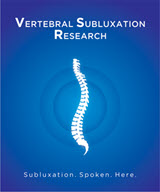Foundation for Vertebral Subluxation President has Paper on Mental Health & Chiropractic Published

Christopher Kent DC, JD, President of the Foundation for Vertebral Subluxation and Professor and Director of Evidenced Informed Curriculum & Practice at Sherman College of Chiropractic recently had his paper on Mental Health and Chiropractic published.
CLICK HERE to review the paper
“Research is revealing that there is a relationship between abnormalities in the spine, the nervous system, brain and mental health” stated Dr. Matthew McCoy, a chiropractor, and public health researcher. “Basic science research shows that the proper development and function of the brain relies on proper structure and movement of the spine from an early age.”
Research has shown not only that the developing brain relies on normal structural integrity and joint movement, but that complex neurochemical communication and pathways involved in helping humans to “feel good” are tied into spinal biomechanics and their related neurological pathways.
“It makes perfect sense once you understand the neurological connections between the spine, the brain and how we feel good added Dr. McCoy. “The seat of human emotion is the Limbic System and we know that this system extends all the way down the spinal cord. By removing obstructions in the spine, mental health and well-being are affected.”
Researchers believe that the increase in the diagnosis of such disorders as ADHD, pervasive developmental disorder, Tourette’s Syndrome, obsessive compulsive disorder and other neurodevelopmental disorders for example, have their root in a “perfect storm” of abnormal spinal development coupled with cultural changes.
We now know many naturally occurring brain and spinal cord substances play a role in both emotions and pain reduction, leading to an increased sense of wellbeing.
According to McCoy structural shifts can occur in the spine and lead to obstruction of the nerves which distorts the flow of nerve information in the spinal cord and brain and it is this obstruction, called vertebral subluxations, that chiropractors correct.
According to Kent “Vertebral subluxations may result in autonomic dysregulation, compromising the adaptive capacity of the organism. By analyzing and correcting vertebral subluxations, a patient is placed on a more optimum physiological path, potentially increasing resilience and adaptability."
Kent calls for further research into the effects of vertebral subluxations on mental health, the neurobiological mechanisms involved, and the use of reliable and valid outcome assessments.
Blogs
- The Chiropractic Cartel: A Look Back at Bias in Accreditation and its Imact on Today's Profession
- Inside Montana's Chiropractic Monopoly: ACA & MCA's Brazen Board Takeover
- Concerns Grow About Control of the NY State Chiropractic Board by the ACA - Use of X-ray in NY Under Threat
- Reproductive Health Information and Chiropractic Care: Navigating New Privacy Regulations
- Navigating Substance Use Disorder (SUD) Consent: What Chiropractors Need to Know














